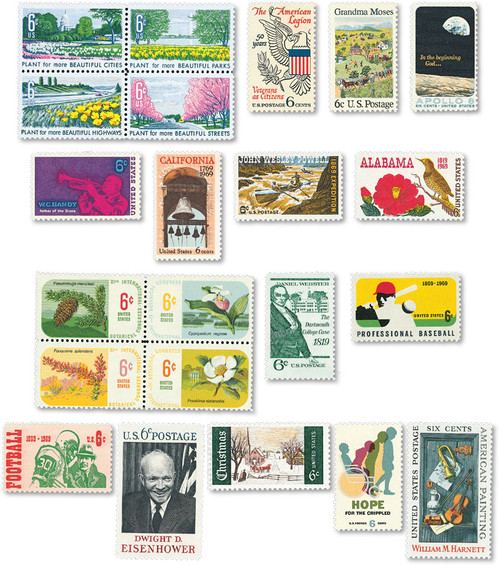
# 1367 - 1969 6c Beautification of America: Plant for more Beautiful Highways
Issue Date: January 16, 1969
Quantity: 192,570,000
Printed By: Bureau of Engraving and Printing
Printing Method: Lithographed, engraved
Perforations: 11
Color: Multicolored
Originally issued attached, as a se-tenant, these stamps publicized First Lady Ladybird Johnson’s personal program for the Beautification of America. Its goal was to encourage Americans to take pride in their country and plant flowers and trees. Each stamp represents a different area improved under this program.
America’s First Superhighway
On October 1, 1940, the Pennsylvania Turnpike opened to drivers. Measuring 160 miles at the time of its opening, it’s considered the first superhighway in the US and helped inspire other state turnpikes and America’s Interstate Highway System. People had long sought a way to cross the mountainous state. Centuries ago, Native Americans followed wilderness trails through the mountains and European settlers established wagon roads. In 1794, the log-paved Philadelphia and Lancaster Turnpike opened, becoming the first successful turnpike in the country. In 1834, Pennsylvania opened a series of canal, railroads, and cable railways across the state to compete with New York’s Erie Canal. Twenty years later, the Pennsylvania Railroad was established between Pittsburgh and Philadelphia. In the 1880s, the South Pennsylvania Railroad began construction to complete with the Pennsylvania Railroad. They eventually reached an agreement in 1885 and construction ended, leaving nine unused tunnels behind. By the early 1900s, automobiles grew in popularity, becoming the main form of transportation. People driving through Pennsylvania’s mountains were limited to a few steep, winding roads that caused many accidents. In 1934, William Sutherland of the Pennsylvania Motor Truck Association and Victor Lecoq of the Pennsylvania State Planning Commission submitted a proposal for a toll highway across the state. Their plan was to create a four-lane highway, similar to Germany’s autobahns. They also suggested using the unused tunnels left behind from the South Pennsylvania Railroad. Approved in May 1937, the turnpike would run from Irwin to Middlesex, a length of 162 miles. The road would include nine tunnels, no grades steeper than three percent, no intersections, driveways, traffic lights, crosswalks, or railroad crossings. President Franklin Roosevelt approved $24 million for the project from the Works Progress Administration, while the state contributed $29 million. Construction on the road began on October 27, 1938. A total of 307 bridges were built to carry the turnpike over existing roads and waterways. There were 11 interchanges, steel guardrails, lighting, and exit signs. Service plazas offering food and gas were built every 30 miles along the road. Billboards were not allowed, and trucks and buses would be permitted to use the highway. By the time it was completed, the road had been built at a cost of $370,000 per mile and was built by 18,000 men, 19 of whom died. The road was originally supposed to open on May 1, 1940, but it was pushed back to allow more time for paving. The road ultimately opened on October 1. Excited drivers began lining up the day before. By the end of its first week, the road had carried over 150,000 vehicles. By the end of the first year, it had carried 5 million cars and earned $3 million. The Pennsylvania Turnpike was the first long-distance, limited-access road in the country. It helped connect the Mid-Atlantic and Midwestern states and reduced travel time between Pittsburgh and Harrisburg from six to two-and-a-half hours. It also became the model for future state turnpikes and America’s Interstate Highway System. Over the years, the Pennsylvania Turnpike was expanded and upgraded, now running 360 miles across the state. It became known as the “Dream Highway,” “the World’s Greatest Highway,” and “the Granddaddy of the Pikes.” It’s been designated a National Civil Engineering Landmark by the American Society of Civil Engineers.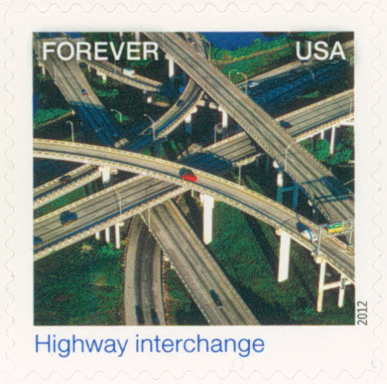

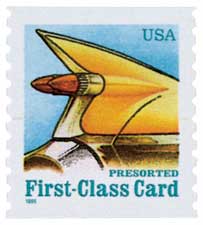
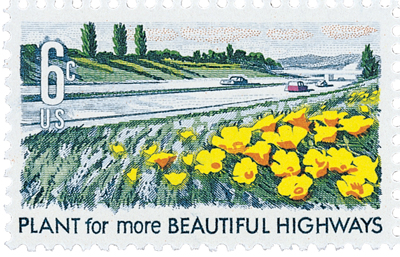
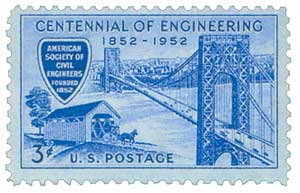
Issue Date: January 16, 1969
Quantity: 192,570,000
Printed By: Bureau of Engraving and Printing
Printing Method: Lithographed, engraved
Perforations: 11
Color: Multicolored
Originally issued attached, as a se-tenant, these stamps publicized First Lady Ladybird Johnson’s personal program for the Beautification of America. Its goal was to encourage Americans to take pride in their country and plant flowers and trees. Each stamp represents a different area improved under this program.
America’s First Superhighway
On October 1, 1940, the Pennsylvania Turnpike opened to drivers. Measuring 160 miles at the time of its opening, it’s considered the first superhighway in the US and helped inspire other state turnpikes and America’s Interstate Highway System. People had long sought a way to cross the mountainous state. Centuries ago, Native Americans followed wilderness trails through the mountains and European settlers established wagon roads. In 1794, the log-paved Philadelphia and Lancaster Turnpike opened, becoming the first successful turnpike in the country. In 1834, Pennsylvania opened a series of canal, railroads, and cable railways across the state to compete with New York’s Erie Canal. Twenty years later, the Pennsylvania Railroad was established between Pittsburgh and Philadelphia. In the 1880s, the South Pennsylvania Railroad began construction to complete with the Pennsylvania Railroad. They eventually reached an agreement in 1885 and construction ended, leaving nine unused tunnels behind. By the early 1900s, automobiles grew in popularity, becoming the main form of transportation. People driving through Pennsylvania’s mountains were limited to a few steep, winding roads that caused many accidents. In 1934, William Sutherland of the Pennsylvania Motor Truck Association and Victor Lecoq of the Pennsylvania State Planning Commission submitted a proposal for a toll highway across the state. Their plan was to create a four-lane highway, similar to Germany’s autobahns. They also suggested using the unused tunnels left behind from the South Pennsylvania Railroad. Approved in May 1937, the turnpike would run from Irwin to Middlesex, a length of 162 miles. The road would include nine tunnels, no grades steeper than three percent, no intersections, driveways, traffic lights, crosswalks, or railroad crossings. President Franklin Roosevelt approved $24 million for the project from the Works Progress Administration, while the state contributed $29 million. Construction on the road began on October 27, 1938. A total of 307 bridges were built to carry the turnpike over existing roads and waterways. There were 11 interchanges, steel guardrails, lighting, and exit signs. Service plazas offering food and gas were built every 30 miles along the road. Billboards were not allowed, and trucks and buses would be permitted to use the highway. By the time it was completed, the road had been built at a cost of $370,000 per mile and was built by 18,000 men, 19 of whom died. The road was originally supposed to open on May 1, 1940, but it was pushed back to allow more time for paving. The road ultimately opened on October 1. Excited drivers began lining up the day before. By the end of its first week, the road had carried over 150,000 vehicles. By the end of the first year, it had carried 5 million cars and earned $3 million. The Pennsylvania Turnpike was the first long-distance, limited-access road in the country. It helped connect the Mid-Atlantic and Midwestern states and reduced travel time between Pittsburgh and Harrisburg from six to two-and-a-half hours. It also became the model for future state turnpikes and America’s Interstate Highway System. Over the years, the Pennsylvania Turnpike was expanded and upgraded, now running 360 miles across the state. It became known as the “Dream Highway,” “the World’s Greatest Highway,” and “the Granddaddy of the Pikes.” It’s been designated a National Civil Engineering Landmark by the American Society of Civil Engineers.











